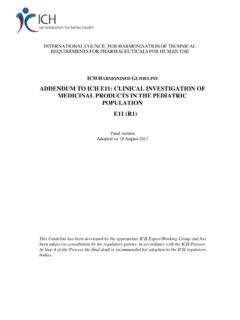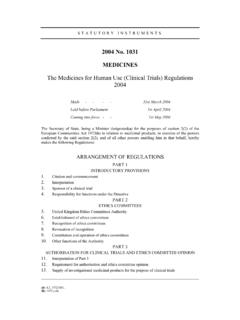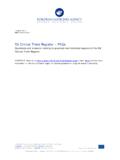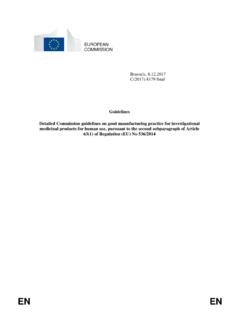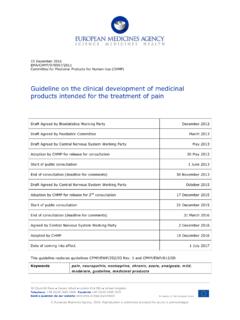Transcription of Guideline on non-clinical and clinical development of ...
1 26 February 2015. EMEA/CHMP/BMWP/32775/2005_Rev. 1. Committee for medicinal products for Human Use (CHMP). Guideline on non- clinical and clinical development of similar biological medicinal products containing recombinant human insulin and insulin analogues Draft revision agreed by BMWP November 2012. Adopted by CHMP for release for consultation 13 December 2012. Start of public consultation 14 December 2012. End of consultation (deadline for comments) 30 June 2013. Draft revision agreed by BMWP April 2014. Adopted by CHMP for release for consultation 25 April 2014. Start of public consultation 30 April 2014. End of consultation (deadline for comments) 31 July 2014. Agreed by BMWP February 2015. Adopted by CHMP 26 February 2015. Date for coming into effect 01 September 2015. This Guideline replaces 'Guidance on similar medicinal products containing recombinant human soluble insulin' (EMEA/CHMP/BMWP/32775/2005). 30 Churchill Place Canary Wharf London E14 5EU United Kingdom Telephone +44 (0)20 3660 6000 Facsimile +44 (0)20 3660 5555.
2 Send a question via our website An agency of the European Union European Medicines Agency, 2015. Reproduction is authorised provided the source is acknowledged. Keywords recombinant human insulin, insulin analogues, similar biological medicinal products, biosimilar, comparability, non- clinical studies, clinical studies, hyperinsulinaemic euglycaemic clamp, glucose clamp. Guideline on non- clinical and clinical development of similar biological medicinal products containing recombinant human insulin and insulin analogues EMEA/CHMP/BMWP/32775/2005_Rev. 1 Page 2/12. Guideline on non- clinical and clinical development of similar biological medicinal products containing recombinant human insulin and insulin analogues Table of contents Executive summary .. 4. 1. Introduction .. 4. 2. 5. 3. Legal basis and relevant guidelines .. 5. 4. Non- clinical studies .. 5. 5. clinical studies .. 7. 6. Pharmacovigilance plan .. 11. 7. Extrapolation of indication.
3 12. 8. Definitions .. 12. Guideline on non- clinical and clinical development of similar biological medicinal products containing recombinant human insulin and insulin analogues EMEA/CHMP/BMWP/32775/2005_Rev. 1 Page 3/12. Executive summary This Guideline lays down the non- clinical and clinical requirements for recombinant insulin-containing products, including human insulin and insulin analogues (both referred to as insulin), claiming to be similar to another one already authorised (the reference medicinal product). The non- clinical section addresses the requirements of in vitro pharmacodynamic studies and cases when there may be a need for additional in vivo toxicological assessment. The clinical section addresses the requirements for pharmacokinetic, pharmacodynamic and safety studies as well as the risk management plan. Compared to the previous version of this Guideline , intermediate-, long-acting insulin preparations and insulin analogues have been included in the scope, a risk-based approach for non- clinical in vivo studies has been introduced and more detailed guidance on the design, study population, insulin doses and endpoints of the insulin clamp study is given.
4 In addition, expectations regarding the safety study have been further clarified and the prerequisites for waiving the safety study have been included. 1. Introduction The Marketing Authorisation (MA) application dossier of a recombinant human insulin or insulin analogue claimed to be similar to a reference medicinal product already authorised shall provide the demonstration of biosimilarity of the product applied for to this reference medicinal product. Human insulin is a non-glycosylated, disulphide-bonded heterodimer of 51 amino acids. Insulin analogues differ from human insulin by the substitution of amino acids or other chemical changes such as addition of a fatty acid chain within the molecule. Insulin preparations differ mainly by their kinetic/pharmacodynamic profiles. They are usually classified as rapid- (faster acting than soluble human insulin), short- ( soluble human insulin), intermediate- ( human isophane insulin = NPH. insulin), and long-acting preparations (insulins with action profiles significantly longer than NPH.)
5 Insulin), and are used alone or as free mixtures or premixed preparations of rapid/short-acting insulin and intermediate/long-acting (biphasic) insulin in various proportions. Suitable physico-chemical and biological methods are available to comprehensively characterise the primary, secondary and tertiary structures of the recombinant insulin molecule, as well as its receptor affinity and biological activity in vitro and in vivo. Attention should be given to product related substances/impurities and process related impurities, and in particular to desamido forms, glycosylated forms and other forms that may derive from the expression system or arise from the conversion steps removing the C-peptide and regenerating the three-dimensional structure. Currently available insulins are administered subcutaneously or intravenously. The effects of insulin are mediated predominantly via stimulation of the insulin receptor but insulin is also a weak natural ligand of the insulin-like growth factor-1 (IGF-1) receptor.
6 Antibodies to insulin occur frequently, mainly as cross-reacting antibodies. These are usually without relevant consequences for efficacy or safety. The potential for development of product/impurity- specific antibodies needs to be evaluated. Possible patient-related risk factors of immune response are unknown. Guideline on non- clinical and clinical development of similar biological medicinal products containing recombinant human insulin and insulin analogues EMEA/CHMP/BMWP/32775/2005_Rev. 1 Page 4/12. 2. Scope The Guideline on similar biological medicinal products containing biotechnology-derived proteins as active substance: non- clinical and clinical issues (EMEA/CHMP/BMWP/42832/2005) lays down the general requirements for demonstration of the similar nature of two biological products in terms of safety and efficacy. This product-class specific Guideline presents the current view of the CHMP on the non- clinical and clinical requirements for demonstration of biosimilarity of two recombinant insulin-containing medicinal products.
7 This Guideline should be read in conjunction with the requirements laid down in the EU. Pharmaceutical legislation and with relevant CHMP guidelines (see section 3 Legal Basis and relevant guidelines). 3. Legal basis and relevant guidelines Directive 2001/83/EC, as amended, in particular in Directive 2001/83/EC Art 10(4) and Part II of the Annex I of Directive 2001/83/EC, as amended Guideline on similar biological medicinal products (CHMP/437/04 Rev. 1). Guideline on similar biological medicinal products containing biotechnology-derived proteins as active substance: non- clinical and clinical issues (EMEA/CHMP/BMWP/42832/2005 Rev. 1). Guideline on similar biological medicinal products containing biotechnology-derived proteins as active substance: Quality issues (EMA/CHMP/BWP/247713/2012). ICH Guideline S 6 (R1) Preclinical safety evaluation of biotechnology-derived pharmaceuticals (EMA/CHMP/ICH/731268/1998). Guideline on the clinical investigation of the pharmacokinetics of therapeutic proteins (EMEA/CHMP/ 89249/2004).
8 Guideline on the investigation of bioequivalence (CPMP/EWP/QWP/1401/98). Guideline on Immunogenicity Assessment of Biotechnology-derived Therapeutic Proteins (EMEA/CHMP/BMWP/14327/2006). Guideline on good pharmacovigilance practices (EMA/500020/2012). Guideline on good pharmacovigilance practices, Module V Risk management systems (EMA/838713/2011). 4. Non- clinical studies Before initiating clinical development , non- clinical studies should be performed. These studies should be comparative in nature and should be designed to have appropriate sensitivity to detect relevant differences in the response to the similar biological medicinal product and the reference medicinal product and should not just assess the response per se. The approach taken will need to be fully justified in the non- clinical overview. Pharmacodynamic studies In vitro studies Guideline on non- clinical and clinical development of similar biological medicinal products containing recombinant human insulin and insulin analogues EMEA/CHMP/BMWP/32775/2005_Rev.
9 1 Page 5/12. In order to assess any differences in properties between the biosimilar and the reference medicinal product, comparative in vitro bioassays for receptor binding, as well as tests for subsequent biological activity should be performed. Partly, such data may already be available from bioassays that were used to measure potency in the evaluation of physico-chemical characteristics. It is important that assays used for comparability testing are demonstrated to have appropriate sensitivity to detect any relevant differences and that experiments are based on a sufficient number of replicates, dilutions or time points per curve to characterise the whole concentration-response or time-response relationship accurately. Biosimilar and reference product should be compared head-to-head in the same experiment. All assays should include appropriate controls to demonstrate the validity and suitability of the method. Comparative receptor binding on both human insulin receptors (IR-A and IR-B), including on-off kinetics, should be shown.
10 To this end, either cells artificially expressing IR-A and IR-B, respectively, can be used. If cell lines with endogenous expression of IR-A or IR-B are employed, it has to be demonstrated that indeed only one receptor subtype is present. Otherwise, interpretation of the binding results is difficult. If other state-of-the-art methods are used for determining binding, the choice of the method should be justified. Biological activity should be compared at two levels: receptor autophosphorylation and metabolic activity. In general, mitogenic activity mediated by IGF-1 receptor stimulation might not be relevant for human insulin and for most insulin analogues. However, if applicable, comparative IGF-1 receptor binding and an assay for functional activity can be included to cover this potential toxicological effect. For receptor autophosphorylation, care should be taken that the dynamic range of the detection method used in the assay is not too limited which would reduce ability to detect relevant differences in levels of receptor autophosphorylation.










